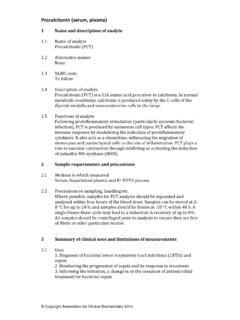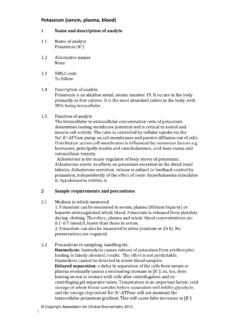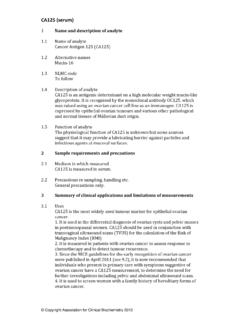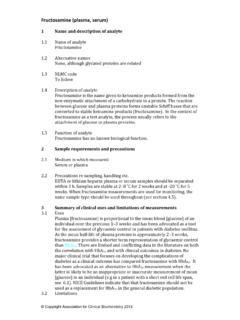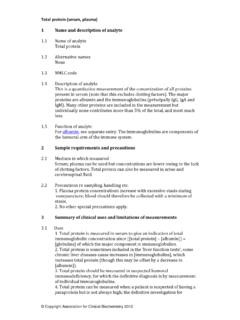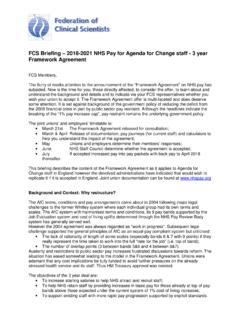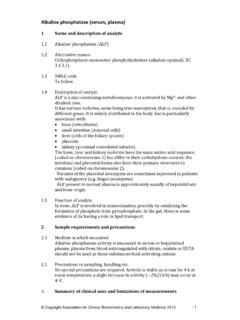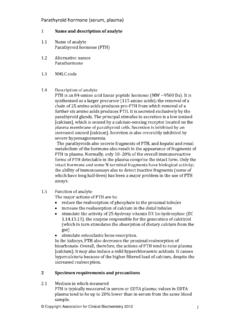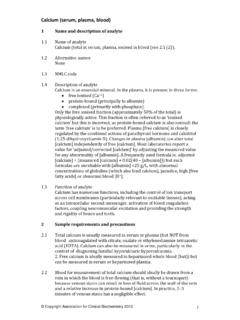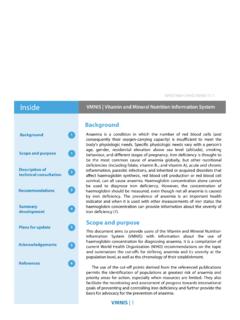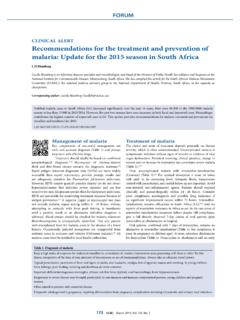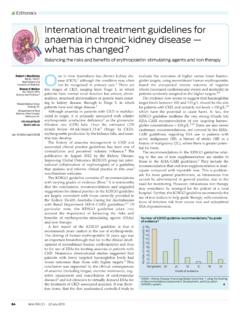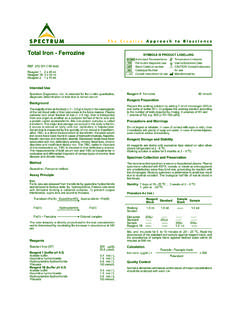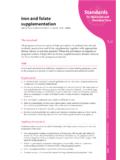Transcription of Glucose (Blood, serum, plasma)
1 Glucose ( blood , serum , plasma ) 1 Name and description of analyte Name of analyte Glucose ( plasma ; also blood , serum ) Alternative names None, though when used therapeutically, Glucose is often referred to as dextrose'. NMLC code Description of analyte Glucose is a monosaccharide hexose sugar. Function of analyte Glucose is an obligate metabolic fuel for some tissues ( erythrocytes) and preferred fuel (particularly in the short term) for many others ( central nervous system). In the body, there are three sources: dietary carbohydrate; gluconeogenesis ( from lactate) and hepatic glycogenolysis. Glycogen is a Glucose polymer and the principal storage form. Glycogen is also stored in skeletal muscle but the Glucose derived from it is not released into the circulation. Glucose concentrations in the blood are maintained within a narrow range by the action of various hormones, the principal of which are insulin (which has hypoglycaemic actions) and glucagon (hyperglycaemic).
2 2 Sample requirements and precautions Medium in which measured 1. Glucose can be measured in blood , serum or plasma : this article refers only to measurements in these fluids made in laboratories. Point of care testing (using capillary blood ) is well established. Interstitial fluid [ Glucose ] measurement and non invasive (extracorporeal) measurements are not considered here. 2. Glucose can also be measured in cerebrospinal fluid as an adjunct to the diagnosis of meningitis. It was formerly proposed that its measurement in pleural fluid could contribute to distinguishing between an aspirate and an exudate, but it is of no value in this context. 3. Measurement of Glucose in urine is the subject of a separate entry. Precautions re sampling, handling etc. Glucose is the obligate source of energy for erythrocytes; because of this, [ Glucose ] falls in whole blood in vitro (at a rate of mmol/L/h at room temperature, lower if unrefrigerated) unless an inhibitor of glycolysis is present.
3 For this reason, blood for Glucose measurement is usually collected into tubes containing fluoride (as an inhibitor of glycolysis) and citrate, EDTA or oxalate (as anticoagulants). [ Glucose ] is stable in plasma or serum only after the fluid has been separated and removed from the cellular elements, although for practical purposes is suitable for use provided that no more than 90 minutes has elapsed before separation and Copyright Association for Clinical Biochemistry 2012 1. there is no bacterial contamination or leucocytosis. Note that blood [ Glucose ] tends to be up to 10 15% lower than serum or plasma [ Glucose ] because of its lower intracellular concentration, although the exact percentage depends on haematocrit and the rate of any change in [ Glucose ]. Note that because of the high risk of artefact, there should be a low threshold for repeating measurements of [ Glucose ] when an unexpectedly abnormal result is found.
4 3 Summary of clinical uses and limitations of measurements Uses 1. Diagnosis and monitoring of the treatment of diabetes mellitus and other hyperglycaemic conditions and monitor patients at risk of developing these conditions. 2. Diagnosis and monitoring the treatment of hypoglycaemia and monitoring patients at risk of developing hypoglycaemia 3. Monitoring patients receiving Glucose containing intravenous fluids. Limitations Measurements of Glucose cannot provide information as to the cause of either hyper or hypoglycaemia. Note that diagnostic values for [ Glucose ] in this article refer to measurements in venous plasma unless where stated otherwise. 4 Analytical considerations Analytical methods Glucose is measured using enzymatic methods. Formerly used non . enzymic colorimetic methods are obsolete.
5 Any of three enzymes may be used: hexokinase, Glucose dehydrogenase and Glucose oxidase in reactions either coupled to a chromophore or involving the generation of an electric current. The assays that generate electric current are particularly suitable for use in point of care instruments. 1. Hexokinase ( ) coupled with Glucose 6 phosphate dehydrogenase ( D Glucose 6 phosphate: NAD(P)+ 1 oxidoreductase, EC ) (GD). The reactions are: Glucose + MgATP (HK) Glucose 6 phosphate (G6P) + MgADP G6P + NAD(P)+ (GD) 6 phosphogluconolactone + NAD(P)H + H+ The formation of NAD(P)H is measured spectrophotometrically at 340 nm. This method, using a specimen blank, is the most widely used. Hexokinase methods can also be used in methods with chromogens to produce a coloured product. 2. Glucose dehydrogenase ( D Glucose : NAD(P)+ 1 oxidoreductase EC ).
6 The reaction is: Glucose + NAD+ (G6P dehydrogenase) 6 phosphogluconolactone + NADH The formation of NADH is measured spectrophotometrically at 340 nm. Copyright Association for Clinical Biochemistry 2012 2. 3 Glucose oxidase ( D Glucose : oxygen 1 oxidoreductase, EC ) With generation of a colour chromogen using peroxidase (Mn(II) hydrogen peroxide oxidoreductase, EC ) Glucose + O2 ( Glucose oxidase) gluconolactone + H2O2 H2O2 + chromogenic oxygen acceptor ( o diansidine) (peroxidase) colour chromogen + H2O Using polarography In this variant, the consumption of oxygen is measured directly. Glucose oxidase is specific for D Glucose , whereas in solution, Glucose is approximately 2/3 in the form and 1/3 in the . Kits incorporate mutarotase to convert the form to the . The major routine methods are based on hexokinase or Glucose oxidase.
7 The Glucose oxidase method is suitable for use in dry slide techniques. Reference method A version of the hexokinase enzymatic method (see ) in which serum or plasma is first deproteinated. Reference material D Glucose (Standard Reference Material (SRM) 917, National Bureau of Standards, Washington DC, USA). Interfering substances 1. Hexokinase method: haemolysis (Hb > g/dL) causes negative, and bilirubin and triglycerides (> 55 mmol/L), positive, interference. 2. Glucose oxidase method: peroxidase is inhibited by various substances including bilirubin and haemoglobin, leading to low results. Sources of error The Glucose oxidase polarography method is not suitable for whole blood because red cells consume oxygen. 5 Reference intervals and variance Reference intervals blood [ Glucose ] varies in relation to food intake.
8 Cut off values for diagnosis of conditions of impaired Glucose tolerance are discussed in section 9. Lower reference limits are defined for fasting specimens: the value at which symptoms of hypoglycaemia become apparent is highly variable between individuals. A value of < mmol/L (venous plasma ) is commonly used, but decreased endogenous insulin secretion may be detectable at < mmol/L. Upper reference limits are defined for fasting and post standardised Glucose intake specimens. Two values are recommended for the upper reference limit (fasting): mmol/L (American Diabetic Association, ADA) and mmol/L (World Health Organisation, WHO). For non fasting values, see ( ). Copyright Association for Clinical Biochemistry 2012 3. The same reference limits apply across the entire age range, and do not differ between males and females.
9 Extent of variation Interindividual CV: Intraindividual CV: Index of individuality: CV of method: typically <2% Critical difference: 24% The variation in [ Glucose ] is due to the time since (and the nature of) the last meal and factors that the removal of Glucose from the blood , particularly the hormonal milieu and requirements for energy consumption. 6 Clinical uses of measurements and interpretation of results Uses and interpretation 1. Diagnosis of diabetes mellitus Diabetes may be suspected on clinical grounds or screened for in individuals at risk, patients with pancreatic insufficiency, endocrinopathies known to cause hyperglycaemia etc. Diabetes mellitus is diagnosed if venous plasma Glucose is mmol/L (fasting) or mmol/L (2 h after ingestion of 50 g anhydrous Glucose or equivalent ( the oral Glucose tolerance test) in a symptomatic patient; in an asymptomatic patient, a second such value must be demonstrated on a different day.)
10 2. Diagnosis of impaired Glucose tolerance and impaired fasting glycaemia Impaired Glucose tolerance is diagnosed if fasting Glucose is < mmol/L and 2 h post Glucose ingestion Glucose is mmol/L but < mmol/L; Impaired fasting glycaemia is diagnosed on WHO criteria if fasting Glucose is mmol/L and < mmol/L. 3. Monitoring treatment of established diabetes blood Glucose measurements, often by patients, can provide important information to guide treatment, especially when intensive insulin regimens are used. Measurements of glycated haemoglobin (HbA1c) are preferred for assessment of the adequacy of treatment over the longer term. Measurements of Glucose are also required to confirm a clinical diagnosis of hypoglycaemia (see (7)). 4. Monitoring treatment of hyperglycaemia Glucose measurements are essential to inform the management of diabetic ketoacidosis and hyperosmolar non ketotic hyperglycaemia.
